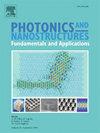Photonic band gap atlas, formula extension, and design applications in 1D photonic crystals
IF 2.5
3区 物理与天体物理
Q3 MATERIALS SCIENCE, MULTIDISCIPLINARY
Photonics and Nanostructures-Fundamentals and Applications
Pub Date : 2025-02-01
DOI:10.1016/j.photonics.2025.101355
引用次数: 0
Abstract
The design and development of new photonic devices for technological applications require a deep understanding of the effects of structural properties on the resulting band gap size and its position. In this study, we perform a theoretical analysis of the behavior of photonic band gap sizes, positions, and percentages under variations of the parameters characterizing binary (two materials), ternary (three materials), and linear continuum dielectric function multilayer structures. The resulting band gap atlas shows that binary systems may suffice for most applications, but ternary systems can provide additional design flexibility if needed. Linear continuum dielectric function systems exhibit a regular pattern for all gaps studied, and this regularity is reproduced with only a few materials involved. The positions of the gaps demonstrate a very monotonous behavior across all calculations performed. Finally, we propose additional extensions of formulas commonly used in the design of Bragg mirrors/reflectors using binary materials, discussing their corresponding limitations. These results can be seen as a technological horizon for the development of photonic devices.
求助全文
约1分钟内获得全文
求助全文
来源期刊
CiteScore
5.00
自引率
3.70%
发文量
77
审稿时长
62 days
期刊介绍:
This journal establishes a dedicated channel for physicists, material scientists, chemists, engineers and computer scientists who are interested in photonics and nanostructures, and especially in research related to photonic crystals, photonic band gaps and metamaterials. The Journal sheds light on the latest developments in this growing field of science that will see the emergence of faster telecommunications and ultimately computers that use light instead of electrons to connect components.

 求助内容:
求助内容: 应助结果提醒方式:
应助结果提醒方式:


